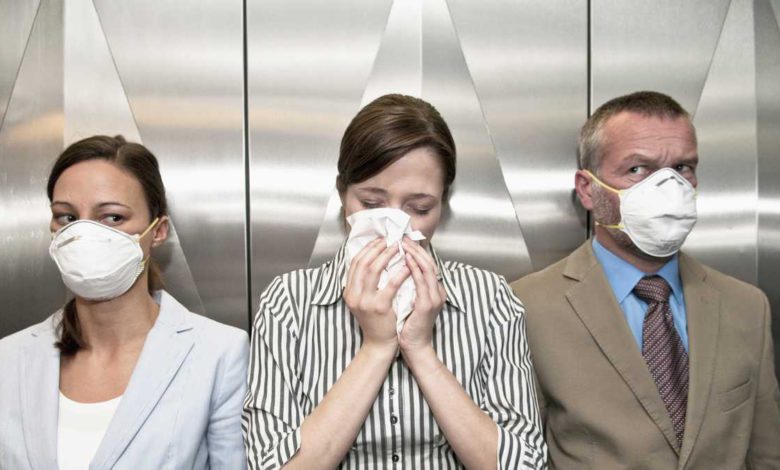
COULD BE THE CASE. MEN:GA WE’VE HEARD TIME AND TIME AGAIN THE PAST SEVERAL MONTHS. >> THE MORE PEOPLE THAT ARE VACCINATEDHE T BETTER PROTECTED ALL OF US ARE. MEN:GA BUT DR. JOSH SCHAFFZIN WITH CINCINNATI CHILDREN’S ISN’T TALKING ABOUT THE COVID VACCINE, HE’S TALKING ABOUT THE FLU. WHILE WE CAN’T PREDICT WHATIL W HAPPEN, EXPERTS SAY THIS COULD BE A BAD FLU SEASON. RESEARCHERS SAY THERE WAS A LACK OF F LLUAST YEAR DUE TO SOCIAL DISTANCING, MASK-WEARING, AND SCHOOL CLOSURE AND DECREASED TRAV.EL AND NOW, WE ARE WHAT’S CALLED IMMUNITY DEBT, WE HAVE A LOFK IMMUNITY TO THE FLU VIRUS DUE TO LACK OF EXPOSURE, ESPECIALLY YOUNG KIDS. DR. SCHAFFZIN SAYS IT’S WHAT DOCTORS BELIEVE HAPPENED WITH RSV. ERTHE WAS NO RSV SEASON LAST YEAR, AND NOW THEY’RE SEEINAG SPIKE IN CHILDREN IN THE LAST COUPLE MONS.TH >> WE HAVE A LARGE ENOHUG POPULATION WHO DON’T VEHA NATURAL IMMUNITY OR ANY IMMUNITY TO A GIVEN DISEASE AND SO WNO YOU SEE MORE OF THE DISEASE BECAUSE YOU GET A FEW CASES THE DISEASE IS ABLE TO ESTABLISH. GAME THE BEST WAY TO GET OUT OF THIS DEBT AND AVOID SEVERE DISEASE IS BY BUILDING UP URYO IMMUNITY TO THE INFLUENZA VIS.RU AND DOCTORS SAY THE BEST WAY TO DO THAT IS BY HEADING WNDO TO YOUR LOCAL PHARMACY AND GETTING YOUR FLUHO S SO EY. DR. SCHAFFZIN SAYS ONCE WE START RELAXING MEASURES, EVEN FOR FOLKS WHO ARE VACCINATED AGASTIN COVID THERE’S GOING TOE B VULNERABLITY TO OTHER PATHOGENS. >> WE CAN AFFECT THE FUTE.UR AND I THINK THE BEST WE CADO IS PREPARE FOR A SEVERE SEASON. DO EVERYTHING WE CAN TO PREVT AND HOPEFULLY EXPEREINCE A SITUATION WHERE WE HAVE HA ALY SEAS AONT ALL. THAT’S A GOOD SIUTATION TO BE IN. MEGAN: DR.
How does the flu spread and how do you protect yourself? Infectious disease experts explain
Plus, the best ways to keep those droplets and particles from infecting you.
By now, you’ve probably memorized all the possible ways you can get COVID-19. So if you’re feeling like a bit of an armchair infectious disease expert, you might be wondering how other illnesses in your life spread, like the flu.Sure, you’ve known practically your whole life that good hand hygiene and doing your best to steer clear of people who are sick is a good way to lower your risk of influenza. But how does the flu really spread? Is the flu airborne or not? Here’s what you need to know. What is the flu, again?The flu is a contagious respiratory illness called by influenza viruses, according to the Centers for Disease Control and Prevention. There are two main types of the flu — influenza A and B — and they cause seasonal flu epidemics each year. The flu can cause mild to severe illness, and it can cause people to be hospitalized and even die from the virus. OK, so how does the flu spread?The flu mainly spreads from person to person, and the CDC says that infected people can spread the virus to people up to six feet away. The flu usually spreads through respiratory droplets that emerge when infected people cough, sneeze or talk.Those droplets can then land in the mouths or noses of people who are nearby or be inhaled into the lungs and make them sick. Less commonly, people can get the flu from touching an infected surface or object and then touching their own mouth, nose, or eyes, the CDC says. Is the flu virus airborne?It can be, but it’s not the primary way the flu is transmitted. An airborne particle is a small particle that can remain suspended in the air for a certain period of time. Respiratory droplets are heavier and therefore fall to the ground pretty quickly after they’re expelled from a person, said Richard Watkins, M.D., an infectious disease physician and professor of internal medicine at the Northeast Ohio Medical University. The CDC says that the flu is largely spread through respiratory droplets. However, it also says airborne transmission can occur, but not over long distances, and not as commonly as via the droplets. “The flu, like many respiratory viruses, has some components of airborne spread and some components of respiratory droplets spread,” explained infectious disease expert Amesh A. Adalja, M.D., a senior scholar at the Johns Hopkins Center for Health Security. “It is really a continuum.”There are some situations where the flu is more likely to generate aerosols and become airborne, like when a person is intubated in a hospital, Adalja said. But he stresses that this is different from a highly contagious airborne virus like measles, which is primarily spread through the air. William Schaffner, M.D., an infectious disease specialist and professor at the Vanderbilt University School of Medicine, agrees. “The data would indicate this only happens under certain circumstances,” he said. “The flu is spread overwhelmingly through close personal contact.” However, the flu may be more likely to hover in the air in the winter, when the air is drier, Schaffner points out. “That little bit of fluid that covers the particles evaporates and they’re not as heavy,” he said. “That’s one of the reasons it’s thought that influenza is more common in the winter — the air is drier then.”Will COVID-19 prevention measures protect people from the flu, too?Definitely. “Mask wearing, social distancing, and hand washing are effective prevention methods for flu avoidance,” Watkins said. “Which is why last year we saw a record low number of flu cases.”“Last season, we had almost no flu and all of us were staying home, washing our hands, and wearing masks,” Schaffner said. “It all had a profound effect on reducing the influenza virus.” However, note that the COVID-19 vaccine will not protect you against the flu.What else can you do to stop the spread of the flu?Getting vaccinated against the flu is a must, Adalja said. The flu vaccine has been shown to reduce flu-related illnesses and the risk of complications that can lead to hospitalization and death, the CDC points out. Some other tips from the CDC: Stay away from people who are sick Cover your coughs and sneezes Wash your hands oftenIf you’re high risk for flu complications, Schaffner recommends doing your best to practice social distancing when influenza is circulating in your community. “Maybe rent a movie instead of going to a movie,” he said.
By now, you’ve probably memorized all the possible ways you can get COVID-19. So if you’re feeling like a bit of an armchair infectious disease expert, you might be wondering how other illnesses in your life spread, like the flu.
Sure, you’ve known practically your whole life that good hand hygiene and doing your best to steer clear of people who are sick is a good way to lower your risk of influenza. But how does the flu really spread? Is the flu airborne or not? Here’s what you need to know.
What is the flu, again?
The flu is a contagious respiratory illness called by influenza viruses, according to the Centers for Disease Control and Prevention. There are two main types of the flu — influenza A and B — and they cause seasonal flu epidemics each year.
The flu can cause mild to severe illness, and it can cause people to be hospitalized and even die from the virus.
OK, so how does the flu spread?
The flu mainly spreads from person to person, and the CDC says that infected people can spread the virus to people up to six feet away. The flu usually spreads through respiratory droplets that emerge when infected people cough, sneeze or talk.
Those droplets can then land in the mouths or noses of people who are nearby or be inhaled into the lungs and make them sick. Less commonly, people can get the flu from touching an infected surface or object and then touching their own mouth, nose, or eyes, the CDC says.
Is the flu virus airborne?
It can be, but it’s not the primary way the flu is transmitted. An airborne particle is a small particle that can remain suspended in the air for a certain period of time. Respiratory droplets are heavier and therefore fall to the ground pretty quickly after they’re expelled from a person, said Richard Watkins, M.D., an infectious disease physician and professor of internal medicine at the Northeast Ohio Medical University.
The CDC says that the flu is largely spread through respiratory droplets. However, it also says airborne transmission can occur, but not over long distances, and not as commonly as via the droplets.
“The flu, like many respiratory viruses, has some components of airborne spread and some components of respiratory droplets spread,” explained infectious disease expert Amesh A. Adalja, M.D., a senior scholar at the Johns Hopkins Center for Health Security. “It is really a continuum.”
There are some situations where the flu is more likely to generate aerosols and become airborne, like when a person is intubated in a hospital, Adalja said. But he stresses that this is different from a highly contagious airborne virus like measles, which is primarily spread through the air.
William Schaffner, M.D., an infectious disease specialist and professor at the Vanderbilt University School of Medicine, agrees. “The data would indicate this only happens under certain circumstances,” he said. “The flu is spread overwhelmingly through close personal contact.”
However, the flu may be more likely to hover in the air in the winter, when the air is drier, Schaffner points out. “That little bit of fluid that covers the particles evaporates and they’re not as heavy,” he said. “That’s one of the reasons it’s thought that influenza is more common in the winter — the air is drier then.”
Will COVID-19 prevention measures protect people from the flu, too?
Definitely. “Mask wearing, social distancing, and hand washing are effective prevention methods for flu avoidance,” Watkins said. “Which is why last year we saw a record low number of flu cases.”
“Last season, we had almost no flu and all of us were staying home, washing our hands, and wearing masks,” Schaffner said. “It all had a profound effect on reducing the influenza virus.”
However, note that the COVID-19 vaccine will not protect you against the flu.
What else can you do to stop the spread of the flu?
Getting vaccinated against the flu is a must, Adalja said. The flu vaccine has been shown to reduce flu-related illnesses and the risk of complications that can lead to hospitalization and death, the CDC points out.
Some other tips from the CDC:
- Stay away from people who are sick
- Cover your coughs and sneezes
- Wash your hands often
If you’re high risk for flu complications, Schaffner recommends doing your best to practice social distancing when influenza is circulating in your community. “Maybe rent a movie instead of going to a movie,” he said.
Source link







